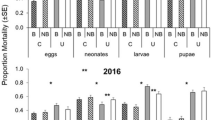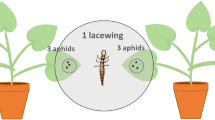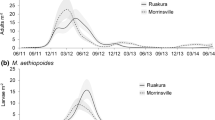Abstract
With the prospect of warmer temperatures as a consequence of ongoing climate change, it is important to investigate how such increases will affect parasitoids and their top-down suppression of herbivory in agroecosystems. Here we studied how the performance and biocontrol efficiency of the willow “bodyguard” Perilitus brevicollis Haliday (Hymenoptera: Braconidae) were affected at different constant temperatures (10, 15, 20, 25°C) when parasitizing a pest insect, the blue willow beetle (Phratora vulgatissima L., Coleoptera: Chrysomelidae). Parasitism did not reduce herbivory at all at 10°C, indicating poor biocontrol efficiency at low temperatures. At higher temperatures, however, parasitism reduced herbivory substantially, implying that biocontrol may be promoted by a warmer climate. Parasitoid performance (survival and development rate) generally increased with increasing temperature up to 20°C. The only exception was body size, which followed the temperature–size rule and decreased with increasing temperature. Our results indicate that a warmer climate may enhance the biocontrol of the blue willow beetle in environments that currently are cooler than the parasitoid’s optimal temperature for development.




Similar content being viewed by others
References
Agboka K, Tounou AK, Al-Moaalem R, Poehling H-M, Raupach K, Borgemeister C (2004) Life-table study of Anagrus atomus, an egg parasitoid of the green leafhopper Empoasca decipiens, at four different temperatures. BioControl 49:261–275
Andrewartha HG, Birch LC (1954) The distribution and abundance of animals. University of Chicago Press, Chicago, USA
Angilletta MJ Jr, Dunham AE (2003) The temperature–size rule in ectotherms: simple evolutionary explanations may not be general. Am Nat 162:332–342
Atkinson D (1994) Temperature and organism size—A biological law for ectotherms? Adv Ecol Res 25:1–58
Bale JS, Masters GJ, Hodkinson ID, Awmack C, Bezemer TM, Brown VK, Butterfield J, Buse A, Coulson JC, Farrar J, Good JEG, Harrington R, Hartley S, Jones TH, Lindroth RL, Press MC, Symrnioudis I, Watt AD, Whittaker JB (2002) Herbivory in global climate change research: direct effects of rising temperature on insect herbivores. Glob Change Biol 8:1–16
Björkman C, Bengtsson B, Häggström H (2000) Localized outbreak of a willow leaf beetle: Plant vigor or natural enemies? Popul Ecol 42:91–96
Björkman C, Dalin P, Eklund K (2003) Generalist natural enemies of a willow leaf beetle (Phratora vulgatissima): abundance and feeding habits. J Insect Behav 16:747–764
Brière JF, Pracros P (1998) Comparison of temperature-dependent growth models with the development of Lobesia botrana (Lepidoptera: Tortricidae). Environ Entomol 27:94–101
Burnett T (1951) Effects of temperature and host density on the rate of increase of an insect parasite. Am Nat 85:337–352
Butler CD, Trumble JT (2010) Predicting population dynamics of the parasitoid Cotesia marginiventris (Hymenoptera: Braconidae) resulting from novel interactions of temperature and selenium. Biocontrol Sci Technnol 20:391–406
Coley PD (1998) Possible effects of climate change on plant/herbivore interactions in moist tropical forests. Clim Change 39:455–472
Dalin P (2011) Diapause induction and termination in a commonly univoltine leaf beetle (Phratora vulgatissima). Insect Sci 18:443–450
Gilbert N, Raworth DA (1996) Insects and temperature—a general theory. Can Entomol 128:1–13
Godfray HCJ (1994) Parasitoids: behavioral and evolutionary ecology. Princeton University Press, Princeton, USA
Häggström H, Larsson S (1995) Slow larval growth on a suboptimal willow results in high predation mortality in the leaf beetle Galerucella lineola. Oecologia 104:308–315
Hance T, van Baaren J, Vernon P, Boivin G (2007) Impact of extreme temperatures on parasitoids in a climate change perspective. Annu Rev Entomol 52:107–126
Harrington R, Fleming RA, Woiwod IP (2001) Climate change impacts on insect management and conservation in temperate regions: Can they be predicted? Agric For Entomol 3:233–240
IPCC (2007) Climate change 2007: the physical science basis. Summary for policymakers. WMO and UNEF, Geneva, Switzerland
Jalali MA, Tirry L, De Clercq P (2010) Effect of temperature on the functional response of Adalia bipunctata to Myzus persicae. BioControl 55:261–269
Kingsolver JG, Huey RB (2008) Size, temperature, and fitness: three rules. Evol Ecol Res 10:251–268
Landsberg J, Smith M (1992) A functional scheme for predicting the outbreak potential of herbivorous insects under global atmospheric change. Aust J Bot 40:565–577
Le Lann C, Wardziak T, van Baaren J, van Alphen JJM (2011) Thermal plasticity of metabolic rates linked to life-history traits and foraging behaviour in a parasitic wasp. Funct Ecol 25:641–651
Llácer E, Urbaneja A, Garrido A, Jacas J-A (2006) Temperature requirements may explain why the introduced parasitoid Quadrastichus citrella failed to control Phyllocnistis citrella in Spain. BioControl 51:439–452
Logan JA (1988) Toward an expert system for development of pest simulation models. Environ Entomol 17:359–376
Maure F, Brodeur J, Ponlet N, Doyon J, Firlej A, Elguero É, Thomas F (2011) The cost of a bodyguard. Biol Lett 7:843–846
Peacock L, Herrick S, Brain P (1999) Spatio-temporal dynamics of willow beetle (Phratora vulgatissima) in short-rotation coppice willows grown as monocultures or a genetically diverse mixture. Agric For Entomol 1:287–296
Rueda LM, Patel KJ, Axtell RC, Stinner RE (1990) Temperature-dependent development and survival rates of Culex quinquefasciatus and Aedes aegypti (Diptera: Culicidae). J Med Entomol 27:892–898
Sandhu HS, Nuessly GS, Webb SE, Cherry RH, Gilbert RA (2010) Temperature-dependent development of Elasmopalpus lignosellus (Lepidoptera: Pyralidae) on sugarcane under laboratory conditions. Environ Entomol 39:1012–1020
Sibly RM, Atkinson D (1994) How rearing temperature affects optimal adult size in ectotherms. Funct Ecol 8:486–493
Steinbauer MJ, Kriticos DJ, Lukacs Z, Clarke AR (2004) Modelling a forest lepidopteran: phenological plasticity determines voltinism which influences population dynamics. Forest Ecol Manag 198:117–131
Stenberg JA (2012) Plant-mediated effects of different Salix species on the performance of the braconid parasitoid Perilitus brevicollis. Biol Control 60:54–58
Thomson LJ, Macfadyen S, Hoffmann AA (2010) Predicting the effects of climate change on natural enemies of agricultural pests. Biol Control 52:296–306
Tun-Lin W, Burkot TR, Kay BH (2000) Effects of temperature and larval diet on development rates and survival of the Dengue vector Aedes aegypti in north Queensland, Australia. Med Vet Entomol 14:31–37
Wu GM, Barrette M, Boivin G, Brodeur J, Giraldeau LA, Hance T (2011) Temperature influences the handling efficiency of an aphid parasitoid through body size-mediated effects. Environ Entomol 40:737–742
Zandi-Sohani N, Shishehbor P (2011) Temperature effects on the development and fecundity of Encarsia acaudaleyrodis (Hymenoptera: Aphelinidae), a parasitoid of Bemisia tabaci (Homoptera: Aleyrodidae) on cucumber. BioControl 56:257–263
Acknowledgment
This study was funded by the Swedish Research Council Formas.
Author information
Authors and Affiliations
Corresponding author
Additional information
Handling Editor: Dirk Babendreier
Electronic supplementary material
Below is the link to the electronic supplementary material.
Rights and permissions
About this article
Cite this article
Baffoe, K.O., Dalin, P., Nordlander, G. et al. Importance of temperature for the performance and biocontrol efficiency of the parasitoid Perilitus brevicollis (Hymenoptera: Braconidae) on Salix . BioControl 57, 611–618 (2012). https://doi.org/10.1007/s10526-012-9443-5
Received:
Accepted:
Published:
Issue Date:
DOI: https://doi.org/10.1007/s10526-012-9443-5




